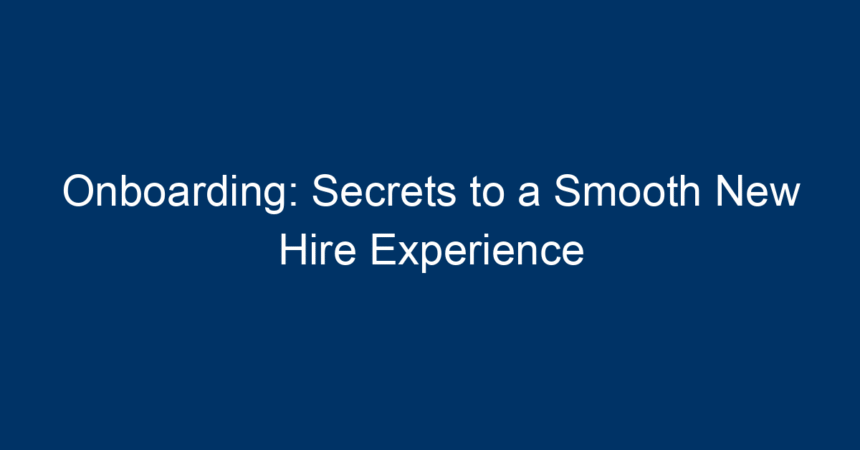In today’s competitive business landscape, hiring top talent is only half the battle. The other half lies in onboarding—a critical process that sets the tone for new employees’ success and satisfaction. A well-structured onboarding experience not only enhances employee engagement but also reduces turnover rates and boosts productivity. If you want your organization to thrive, understanding the secrets to a smooth new hire experience is essential.
The Importance of Onboarding for Employee Success
Onboarding is more than just paperwork and filling out tax forms; it’s a comprehensive process that involves acclimating new hires into the company culture, clarifying job expectations, and providing essential training. According to studies, effective onboarding can improve employee retention by up to 82% and drive nearly 70% higher employee performance.
Enhanced Job Satisfaction
First impressions last, and the onboarding experience significantly influences new hires’ perceptions of their roles and the organization. A structured onboarding program can make employees feel welcomed and valued, leading to increased satisfaction and loyalty.
Faster Time to Productivity
New hires who undergo a structured onboarding process are likely to become productive faster. By integrating them into the workflow and equipping them with the necessary tools, employers can help minimize the time it takes for new team members to hit their stride.
Key Components of Effective Onboarding
1. Pre-Onboarding Preparation
Before your new hire sets foot in the office, the onboarding process should begin. Pre-onboarding is a crucial step that includes:
- Sending Welcome Emails: A personalized email from their manager or team can create excitement and make new hires feel valued even before starting.
- Providing An Onboarding Checklist: Outline what they can expect on their first day, helping to ease anxiety.
- Arranging for Equipment: Ensure that all necessary tools—laptops, software accounts, and access passes—are prepared in advance.
2. Structured Orientation Programs
Orientation is the foundation of onboarding. It’s essential to include the following elements:
- Company Culture Overview: Share your mission, vision, and values to help new hires understand the organizational culture.
- Team Introductions: Facilitate meet-and-greet sessions within teams. This fosters connections and puts a face to the names.
- HR and Policies Briefing: Go over important company policies, procedures, and benefits so that new employees know what to expect.
3. Role-Specific Training
Training should be customized to fit the specific roles of new hires:
- Mentorship Programs: Pairing new employees with experienced mentors can provide guidance and support as they navigate their new roles.
- Hands-On Training: Encourage active learning through workshops, simulations, or shadowing opportunities, allowing new hires to apply their skills in real-world scenarios.
- Setting Clear Goals: Define short-term and long-term objectives that reinforce accountability and performance expectations.
4. Gradual Integration into the Team
A smooth onboarding experience requires gradual integration:
- Check-Ins: Schedule regular one-on-one meetings during the first month to address questions and ensure new hires are adjusting well.
- Social Activities: Arranging team-building activities or informal gatherings can help break the ice and foster camaraderie among team members.
- Feedback Loop: Encourage new hires to share their experiences and provide feedback on the onboarding process. This not only improves the program but also shows that their opinions are valued.
5. Continuous Support
Onboarding shouldn’t end after the first week or month. Continuous support can be pivotal for long-term success:
- Ongoing Training Opportunities: Provide access to further training and development resources, allowing employees to enhance their skills.
- Performance Reviews: Schedule regular evaluations during the initial months to assess progress and provide constructive feedback.
- Career Development Talks: Discuss future career pathways, reinforcing that the company is invested in their growth.
Overcoming Common Onboarding Challenges
Despite the best efforts, onboarding processes can face several challenges. Here’s how to tackle them effectively:
Lack of Standardization
Without a standardized process, onboarding can become inconsistent. Establishing a structured program ensures that all new hires receive the same information and support.
Overloading Information
Bombarding new employees with too much information at once can be overwhelming. Spread information over several days or weeks and use varied formats like videos, manuals, and interactive sessions to enhance retention.
Failure to Personalize
Not all new hires have the same experience or learning style. Tailor onboarding programs to the specific needs of your new employees, considering their backgrounds, skills, and expectations.
Measuring the Success of Your Onboarding Process
To ensure your onboarding process is effective, it’s crucial to measure its success:
1. Employee Feedback
Regularly ask new hires about their onboarding experiences through surveys or focus groups. This will help identify strengths and areas for improvement.
2. Retention Rates
Analyze retention rates among new hires over various time frames. A significant drop-off in early employment can indicate issues within the onboarding process.
3. Performance Metrics
Track key performance indicators to assess the productivity and engagement levels of new hires compared to their peers.
Actionable Insights for a Smooth New Hire Experience
Creating an effective onboarding program doesn’t require a massive overhaul of your existing processes. Here are actionable insights:
-
Invest in Technology: Consider online onboarding platforms that can streamline processes and enhance the experience.
-
Focus on Engagement: Use gamification or interactive content to engage new hires and reduce the monotony of traditional orientation.
-
Maintain Flexibility: Allow room for customization in the onboarding experience to meet the unique needs of each employee.
-
Follow Up: Don’t wait for formal reviews to check in. Regular communication demonstrates your support and commitment to new hires’ success.
- Create a Culture of Continuous Improvement: Embrace feedback from current and past employees to refine your onboarding process continually.
Conclusion
A well-executed onboarding process is crucial for fostering a smooth new hire experience. By focusing on pre-onboarding preparation, structured orientation programs, role-specific training, gradual integration, and continuous support, organizations can pave the way for long-term success. Measure your efforts through feedback and performance metrics to ensure ongoing improvement in your onboarding strategy. Ultimately, with a strategic approach to onboarding, you’ll not only attract top talent but also cultivate a committed and high-performing team that will drive your business forward. Embrace these secrets to maximize the potential of every new hire, transforming them into enthusiastic contributors who are engaged and aligned with your organization’s mission.




